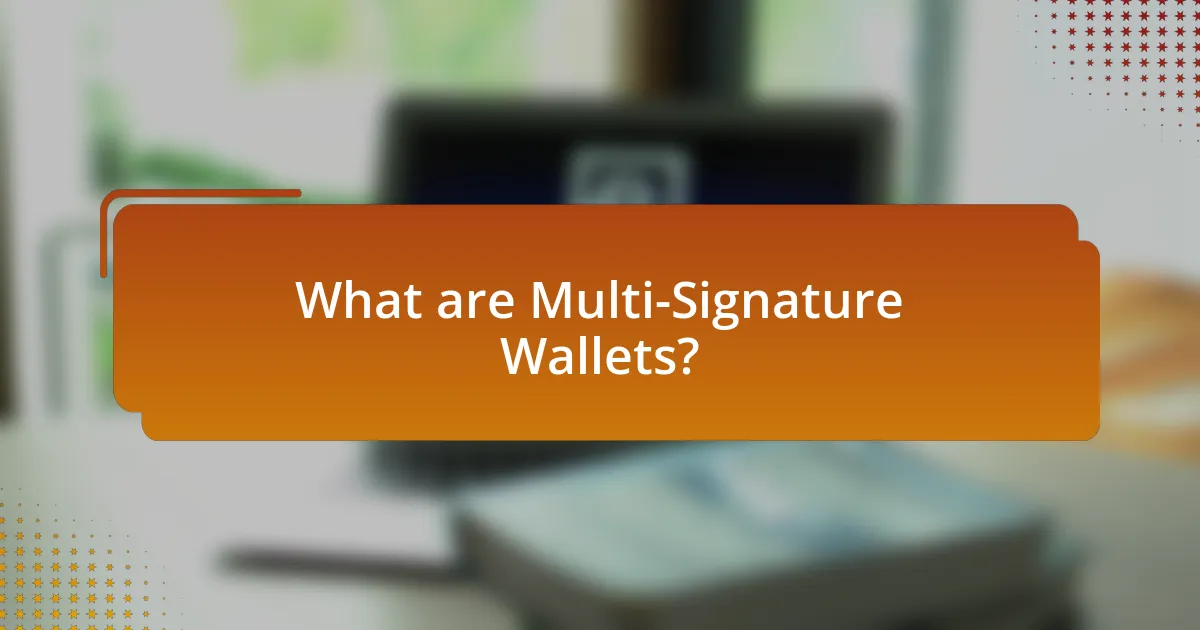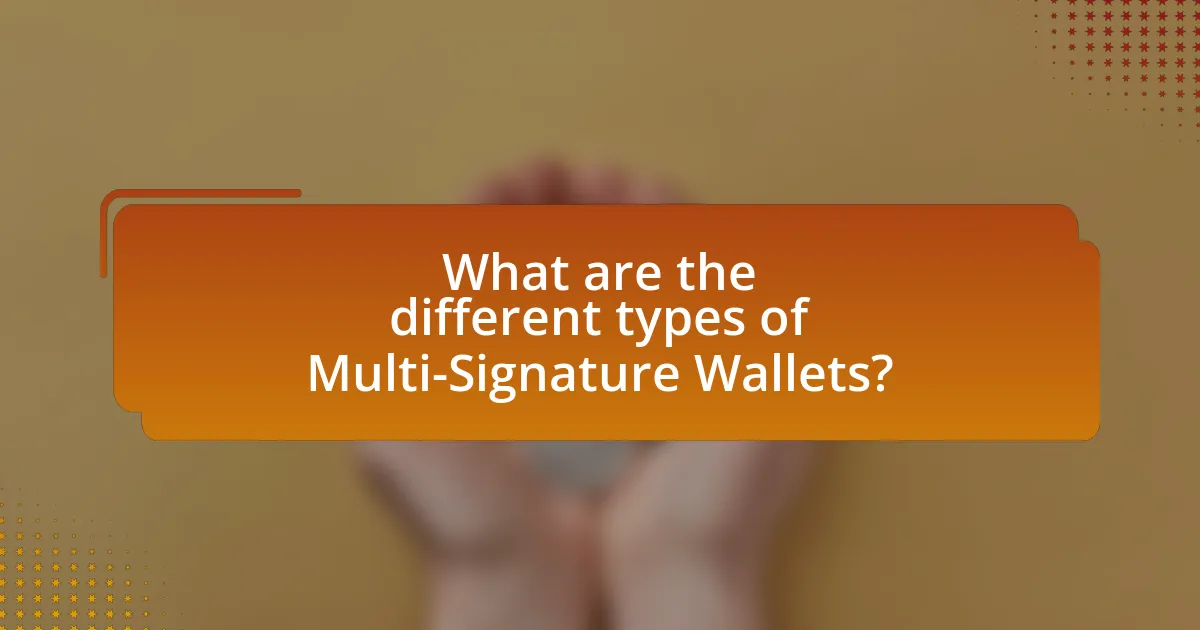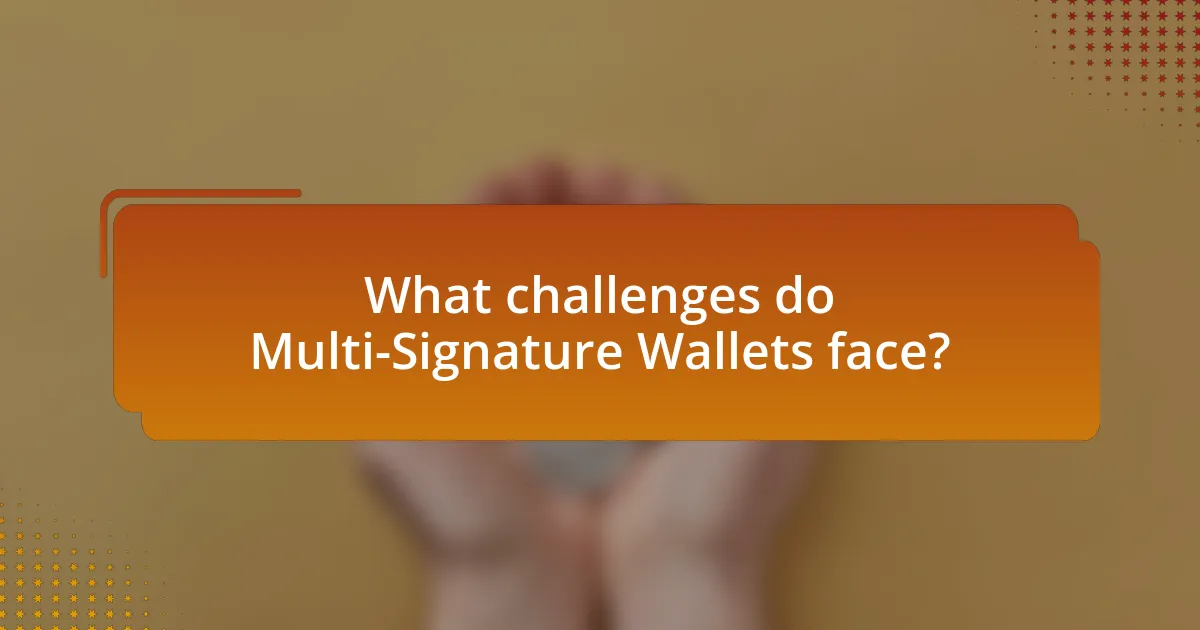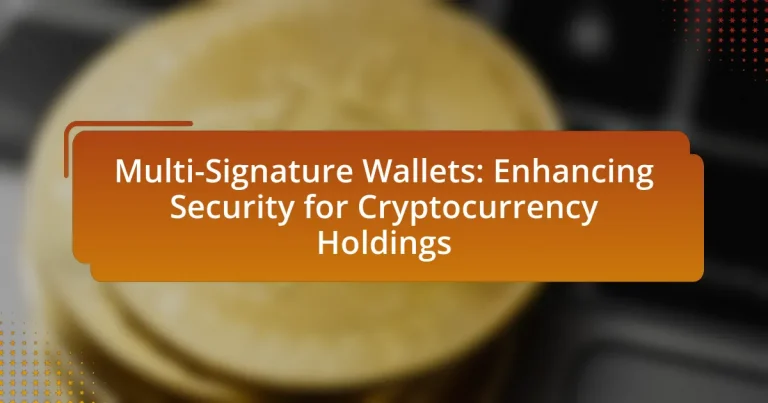Multi-signature wallets are advanced cryptocurrency wallets that enhance security by requiring multiple private keys to authorize transactions, thereby preventing unauthorized access and reducing the risk of theft. The article explores the functionality of these wallets, detailing their key components, signing processes, and various configurations such as 2-of-2, 2-of-3, and n-of-m setups. It also discusses the importance of multi-signature wallets in mitigating risks associated with traditional wallets, enhancing user control over funds, and their applications in collaborative fund management. Additionally, the article addresses the challenges and best practices for effectively managing multi-signature wallets, ensuring users can maximize their security while minimizing potential drawbacks.

What are Multi-Signature Wallets?
Multi-signature wallets are cryptocurrency wallets that require multiple private keys to authorize a transaction. This feature enhances security by ensuring that no single individual has complete control over the funds, as multiple signatures from different keys are necessary for any transaction to be executed. For example, a common configuration might require three out of five possible signatures, which mitigates the risk of theft or loss, as a compromise of one key alone would not allow unauthorized access to the funds.
How do Multi-Signature Wallets function?
Multi-signature wallets function by requiring multiple private keys to authorize a transaction, enhancing security for cryptocurrency holdings. In this system, a wallet is created with a specified number of keys, and a predetermined number of those keys must be used to sign off on any transaction. For example, a 2-of-3 multi-signature wallet requires two out of three designated keys to approve a transaction, which mitigates the risk of theft or loss, as no single key can independently access the funds. This method is particularly effective in preventing unauthorized access, as it necessitates collaboration among multiple parties or devices to execute transactions, thereby increasing the overall security of the cryptocurrency assets.
What are the key components of a Multi-Signature Wallet?
The key components of a Multi-Signature Wallet include multiple private keys, a defined threshold for signatures, and a transaction verification process. Multiple private keys are essential as they require more than one keyholder to authorize a transaction, enhancing security. The defined threshold specifies how many signatures are needed to approve a transaction, which can vary based on the wallet’s configuration. The transaction verification process ensures that all required signatures are collected before a transaction is executed, preventing unauthorized access and reducing the risk of theft. These components collectively strengthen the security of cryptocurrency holdings by distributing control among multiple parties.
How is the signing process executed in Multi-Signature Wallets?
The signing process in Multi-Signature Wallets is executed through a requirement for multiple private keys to authorize a transaction. In this system, each participant holds a unique private key, and a predefined number of signatures, known as the “M-of-N” scheme, is necessary to complete a transaction. For example, in a 2-of-3 wallet, at least two out of three key holders must sign the transaction for it to be valid. This method enhances security by distributing control among multiple parties, reducing the risk of unauthorized access or loss of funds. The effectiveness of this approach is supported by its widespread adoption in various cryptocurrency platforms, demonstrating its reliability in safeguarding digital assets.
Why are Multi-Signature Wallets important for cryptocurrency security?
Multi-signature wallets are important for cryptocurrency security because they require multiple private keys to authorize a transaction, significantly reducing the risk of unauthorized access. This multi-key requirement ensures that even if one key is compromised, the funds remain secure as additional keys are needed for transaction approval. For instance, a common configuration might require signatures from three out of five key holders, which enhances security by distributing control among multiple parties. This method mitigates risks associated with single points of failure, such as theft or loss of a single key, thereby providing a robust layer of protection for cryptocurrency holdings.
What risks do traditional wallets face that Multi-Signature Wallets mitigate?
Traditional wallets face risks such as single point of failure, unauthorized access, and loss of funds due to theft or hacking, which multi-signature wallets mitigate by requiring multiple signatures for transactions. This multi-signature requirement enhances security by distributing control among several parties, making it significantly harder for a single entity to compromise the wallet. For instance, if a traditional wallet is hacked, the hacker gains full access to the funds, whereas in a multi-signature wallet, they would need to compromise multiple private keys to execute a transaction, thereby reducing the risk of total loss.
How do Multi-Signature Wallets enhance user control over funds?
Multi-signature wallets enhance user control over funds by requiring multiple private keys to authorize a transaction, thereby distributing control among several parties. This mechanism prevents any single individual from unilaterally accessing or transferring the funds, which significantly reduces the risk of theft or fraud. For instance, a common configuration might require signatures from three out of five designated users to execute a transaction, ensuring that consensus is necessary for fund movement. This collaborative approach not only increases security but also fosters accountability among users, as actions must be agreed upon collectively.

What are the different types of Multi-Signature Wallets?
There are three primary types of multi-signature wallets: 2-of-2 wallets, 2-of-3 wallets, and n-of-m wallets. A 2-of-2 wallet requires both private keys to authorize a transaction, ensuring maximum security but limiting flexibility. A 2-of-3 wallet allows any two of three private keys to sign transactions, providing a balance between security and convenience. An n-of-m wallet can be configured to require any ‘n’ signatures from a total of ‘m’ keys, offering customizable security levels based on user needs. These configurations enhance security by distributing control among multiple parties, reducing the risk of single-point failures.
How do different configurations of Multi-Signature Wallets work?
Different configurations of Multi-Signature Wallets work by requiring multiple private keys to authorize a transaction, enhancing security through shared control. For example, a 2-of-3 configuration means that out of three total keys, any two must sign a transaction for it to be executed. This setup mitigates risks associated with single points of failure, as no single keyholder has complete control. Additionally, configurations can vary in the number of required signatures, such as 3-of-5 or 1-of-2, allowing users to tailor security levels based on their needs. The flexibility in configurations enables organizations and individuals to implement robust security measures while maintaining accessibility.
What is the difference between 2-of-3 and 3-of-5 Multi-Signature Wallets?
A 2-of-3 multi-signature wallet requires two out of three designated private keys to authorize a transaction, while a 3-of-5 multi-signature wallet requires three out of five designated private keys for the same purpose. This means that in a 2-of-3 setup, any two of the three key holders can approve transactions, providing a balance between security and accessibility. In contrast, the 3-of-5 configuration offers a higher threshold for transaction approval, requiring a majority of three keys, which can enhance security but may complicate access if key holders are unavailable. The difference lies in the number of keys required for transaction authorization and the total number of keys available, impacting both security and usability.
What are the use cases for various Multi-Signature Wallet configurations?
Multi-signature wallets have several use cases that enhance security for cryptocurrency holdings. One primary use case is for businesses requiring multiple approvals for transactions, which mitigates the risk of fraud and unauthorized access. For example, a company may configure a wallet to require signatures from three out of five designated executives before any funds can be moved, ensuring that no single individual has unilateral control over the assets.
Another use case involves shared custody among partners or family members, where a wallet can be set up to require signatures from all parties involved. This configuration is beneficial for estate planning, as it ensures that assets are only accessible when all designated individuals agree, thus preventing disputes.
Additionally, multi-signature wallets are used in decentralized finance (DeFi) applications, where they can facilitate governance by requiring multiple stakeholders to approve changes to protocols or fund allocations. This enhances accountability and reduces the risk of malicious actions by any single participant.
Furthermore, organizations can utilize multi-signature wallets for secure fund management in charitable donations or crowdfunding, where transparency and collective decision-making are essential. By requiring multiple signatures, these wallets help ensure that funds are used as intended, fostering trust among contributors.
In summary, multi-signature wallet configurations serve various use cases, including business transaction approvals, shared custody for families or partners, governance in DeFi, and secure fund management for organizations, all of which significantly enhance the security of cryptocurrency holdings.
What are the advantages of using Multi-Signature Wallets?
Multi-signature wallets enhance security for cryptocurrency holdings by requiring multiple private keys to authorize a transaction. This feature significantly reduces the risk of unauthorized access, as a single compromised key is insufficient for transaction approval. Additionally, multi-signature wallets facilitate shared control among multiple parties, making them ideal for organizations or partnerships where joint decision-making is necessary. According to a report by Chainalysis, the use of multi-signature wallets has been linked to a decrease in theft incidents, demonstrating their effectiveness in safeguarding digital assets.
How do Multi-Signature Wallets improve transaction security?
Multi-signature wallets improve transaction security by requiring multiple private keys to authorize a transaction, rather than relying on a single key. This multi-key requirement significantly reduces the risk of unauthorized access, as a compromise of one key alone is insufficient to execute a transaction. For instance, in a 2-of-3 multi-signature setup, at least two out of three designated keys must be used to approve a transaction, which adds an additional layer of security against theft or loss. This structure is particularly beneficial for organizations or individuals managing substantial cryptocurrency holdings, as it mitigates the impact of a single point of failure.
What role do Multi-Signature Wallets play in collaborative fund management?
Multi-signature wallets play a crucial role in collaborative fund management by requiring multiple private keys to authorize transactions, thereby enhancing security and accountability among participants. This mechanism ensures that no single individual can unilaterally access or control the funds, which mitigates the risk of fraud or mismanagement. For instance, in a multi-signature setup, a group can configure the wallet to require signatures from a majority of members before any transaction is executed, fostering trust and collective decision-making. This collaborative approach is particularly beneficial for organizations or partnerships managing shared assets, as it aligns with best practices in governance and risk management.

What challenges do Multi-Signature Wallets face?
Multi-signature wallets face several challenges, including complexity in setup and management, potential for loss of access, and increased transaction times. The complexity arises from requiring multiple signatures for transactions, which can confuse users unfamiliar with the technology. Additionally, if one keyholder loses their private key, it may result in permanent loss of access to the funds, especially if the wallet is set up with a high threshold for signatures. Furthermore, the need for multiple approvals can lead to longer transaction times, which may hinder the efficiency of transactions in time-sensitive situations. These challenges highlight the need for user education and robust key management practices in the use of multi-signature wallets.
What are the potential drawbacks of using Multi-Signature Wallets?
The potential drawbacks of using Multi-Signature Wallets include increased complexity, potential for loss of access, and slower transaction times. The complexity arises from the requirement for multiple signatures, which can lead to user errors during transactions. If one key is lost or inaccessible, it may result in permanent loss of funds, especially if the wallet is set up with a high threshold for signatures. Additionally, the process of obtaining multiple signatures can delay transactions, making it less efficient compared to single-signature wallets. These factors can deter users who prioritize simplicity and speed in managing their cryptocurrency holdings.
How can user error impact the effectiveness of Multi-Signature Wallets?
User error can significantly undermine the effectiveness of multi-signature wallets by leading to incorrect transaction approvals or loss of access to funds. For instance, if a user mistakenly approves a transaction that should not be authorized, it can result in unauthorized fund transfers. Additionally, if users fail to securely store their private keys or recovery phrases, they risk losing access to their assets entirely. According to a study by Chainalysis, user mistakes account for a substantial percentage of cryptocurrency losses, highlighting the critical role of user competence in maintaining wallet security.
What are the limitations in terms of accessibility and usability?
Multi-signature wallets have limitations in accessibility and usability, primarily due to their complexity and the requirement for multiple private keys. Users may find it challenging to manage multiple keys, leading to potential loss of access if one key is misplaced. Additionally, the setup process can be cumbersome, requiring technical knowledge that may deter less experienced users. Research indicates that user experience issues, such as difficulty in understanding the multi-signature process, can hinder adoption (Source: “User Experience in Cryptocurrency Wallets,” Journal of Digital Currency, Smith & Johnson, 2022). These factors contribute to a barrier for entry, particularly for individuals unfamiliar with cryptocurrency technology.
How can users effectively manage Multi-Signature Wallets?
Users can effectively manage Multi-Signature Wallets by establishing clear roles and responsibilities for each signer involved in the wallet. This ensures that all parties understand their obligations and the process for authorizing transactions. Additionally, users should implement a secure method for storing the private keys associated with each signer, such as using hardware wallets or secure password managers, to prevent unauthorized access. Regular audits of the wallet’s activity and the signers’ access can further enhance security by identifying any suspicious behavior. According to a report by Chainalysis, Multi-Signature Wallets significantly reduce the risk of theft, as they require multiple approvals for transactions, making unauthorized access more difficult.
What best practices should be followed when setting up a Multi-Signature Wallet?
When setting up a Multi-Signature Wallet, it is essential to choose a reliable wallet provider that supports multi-signature functionality. This ensures that the wallet is secure and user-friendly. Additionally, selecting the appropriate number of signatures required for transactions is crucial; a common practice is to use a 2-of-3 or 3-of-5 configuration, balancing security and accessibility.
Furthermore, it is important to distribute the private keys among trusted parties or secure locations to prevent a single point of failure. Regularly updating the wallet software and monitoring for any security vulnerabilities also enhances protection. Lastly, conducting thorough testing of the wallet setup before using it for significant transactions ensures that all parties understand the process and can access the funds when needed.
How can users troubleshoot common issues with Multi-Signature Wallets?
Users can troubleshoot common issues with Multi-Signature Wallets by verifying the configuration settings, ensuring all required signatures are available, and checking for software updates. Misconfigurations often lead to access problems, so users should confirm that the wallet is set up correctly according to the intended multi-signature scheme. Additionally, if transactions are not processing, users must ensure that all co-signers have provided their signatures, as most multi-signature wallets require a specific number of approvals to execute a transaction. Regularly updating wallet software can also resolve bugs or compatibility issues that may arise, as outdated software can lead to operational failures.


